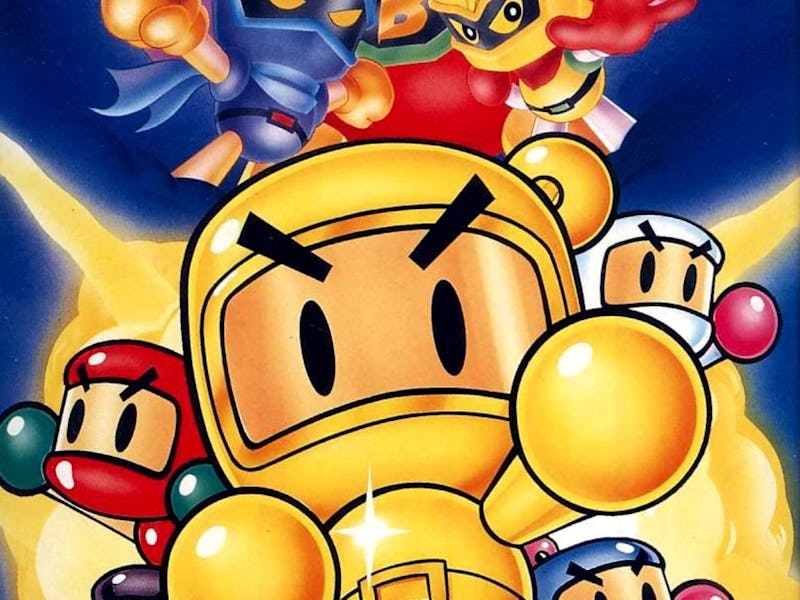How Bomberman Turned Living Rooms Into Battlefields
(And paved the way for the N64’s defining feature.)

We humans can’t escape competition. Thousands of years of evolution put us at the top of the food chain, but once we won the survival of the fittest, we turned it on ourselves. Virtually everything is framed as a contest, from history to sports to romance, not by default but by design. We love organizing ourselves as winners and losers.
Our video games do, too. High scores and head-to-head matchups defined the ‘70s arcade era, and every ‘80s home console had two controller ports for a reason. Four-player games thrived in the late ‘90s N64 era and gave way to the online multiplayer of today. Yet few people remember the bridge between the two was built by a plucky little dude called Bomberman.
Originally released for SNES on April 28, 1994, Super Bomberman 2 was second title in the Super Bomberman series but actually the fourth in the franchise. The single-player story revolves around the Five Dastardly Bombers kidnapping Bomberman at the behest of alien invaders seeking to take over the world. The gameplay is what you’d expect. You need to avoid traps, solve bomb-related puzzles, obliterate baddies and try not to unalive yourself with collateral damage. It’s a fine campaign, but it’s not the reason Super Bomberman 2 has a special place in video game history.
Super Bomberman 2 isn’t a historic “first” by the standard metrics. It’s not the first four-player game, or even the first four-player Bomberman game. Its peripheral, the four-way enabling MultiTap from Hudson Soft (also the game’s developer), isn’t the first of those either. The NES had a similar device called the FourScore produced by Nintendo, which allowed for multiplayer in the not-super, just regular Bomberman 2.
Not all four-player games are created equal, however. The FourScore only had 25 games and most involved four-player co-op. The most notable competitive title was Super Off-Road, a well-received racing title that had built its rep as an arcade staple. Hudson Soft launched the MultiTap with Super Bomberman included, and while the gameplay was innovative it was also limited in scope.
The Super Bomberman 2 instruction manual had the hottest tips and tricks.
Battle Mode in Super Bomberman 2 was a success for reasons that are hard to quantify but easy to understand. The key difference was balance. Super Bomberman 2 multiplayer felt different because of subtle and not-so-subtle changes to the structure. The most significant addition were the Golden Trophy items. If enabled, this feature allows the winner of each match to spin a wheel that delivers a different power-up they can use in the next one. The Bomb Kick was far and away the most OP of the bunch, letting you kick opponents bombs away from you (and back at them).
Each of the maps expanded on the Super Bomberman concept of attaching themes and special conditions to each of the stages, adding another layer to the strategy. One map gives everyone the coveted bomb kick ability, another has conveyor belts, one map lets players jump, and so on. The marriage between maps and items added more depth to the strategy and made the in-person co-op experience intense and addictive in a way four-player games had never seen before. Critics praised the experience, giving it near-perfect scores and placement on several of the decade’s “Best Of” lists.
It wasn’t just fans and press reacting to this new breed of multiplayer mayhem, game devs took notice, too. In 1996, Next Generation magazine ran a list of popular terms new to gaming culture. Included in the list was “Bomb-o’clock,” a reference to a phenomenon in the game dev scene where it seemed like everyone was playing Super Bomberman 2 on their lunch breaks or at the end of the work day. It was followed by an entry for “Bombaholic,” someone who is addicted to playing Super Bomberman 2.
This eBay listing for a Super Bomberman 2 advert captures just how hot the game was in 1994
When it came time for Nintendo to launch its next console, the legendary N64, the hardware improvements allowed it to have four-player split screen. It’s telling that Nintendo developed the FourScore for NES, decided the peripheral wasn’t worth expanding to the SNES, and then made four-player the standard on its next console.
This wasn’t just some technical flex, Nintendo clearly understood the potential of four-player games. Beyond that, a generation of Bombaholic game devs were now given the opportunity to create titles for this platform. Super Smash Bros. in particular owes a debt to Super Bomberman for showcasing how frenetic four-player gameplay can achieve new heights through items and map design. The critical, commercial, and industry success of Super Bomberman 2 established a sterling reputation for the franchise for the rest of the ‘90s. Several SNEs sequels soon followed, each one improving upon the multiplayer formula. Recent reboots have fallen flat, but this pioneering party game still brings up fond memories to everyone who ever ruined a friendship or smashed a controller in its honor.